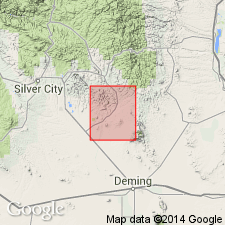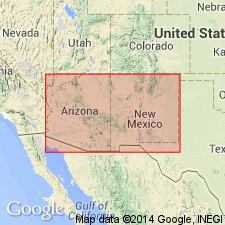
- Usage in publication:
-
- Mimbres Peak formation
- Modifications:
-
- Named
- Dominant lithology:
-
- Tuff
- Sandstone
- Conglomerate
- AAPG geologic province:
-
- Basin-and-Range province
Summary:
Named for Mimbres Peak in sec. 8, T 19 S, R 10 W, Grant Co., NM in the Basin-and-Range province where a "typical section" 450 ft thick was measured. Mapped (geologic map) as part of the "Lower volcanic series" at Mimbres Peak, in Box Canyon, on parts of the Mimbres River, along the Mimbres fault, near Mimbres Hot Springs, and in the Gila National Forest, all in the northern part of the quad., Grant Co. May be equivalent to the White Eagle rhyolite (named) of the northern Cook Range, and the Faywood rhyolite (first used) of Mimbres Mountain and Faywood Hot Springs area. Is younger than Kneeling Nun tuff and older than Box Spring rhyolite (named). Is made up of rhyolite flows and their intrusive equivalents, abundant pumiceous tuffs, tuffaceous sandstones, conglomerates, sandy tuffs, and perlite. Four rock types mapped. The "typical section" divisible into (ascending): 1.) bedded tuffs and sandstones 150+-ft thick, 2.) bedded pumiceous rhyolite tuffs with fragments of silicified rhyolite 66 ft thick, 3.) black perlite flow rock 0-50 ft thick, 4.) massive, gray spherulitic flow rhyolite 0-30 ft thick, 5.) pink and gray banded flow rhyolite 160+ ft thick. The flow rocks and the intrusive rocks have identical lithologies; they have alternating gray and pink bands, 1-2 mm wide, and are strongly flow banded. In thin section, they appear as fine-grained, irregular aggregates of quartz, sanidine, and oligoclase, with sparse phenocrysts of oligoclase. Pumiceous tuffs are stratified in beds 2-6 ft thick. Tertiary age assigned.
Source: GNU records (USGS DDS-6; Denver GNULEX).

- Usage in publication:
-
- Mimbres Peak flow-banded rhyolite
- Modifications:
-
- Paleomagnetics
- AAPG geologic province:
-
- Basin-and-Range province
Summary:
In the Dwyer quad, southeast of Silver City, Grant Co, NM, Basin-and-Range province, Caballo Blanco Rhyolite and Box Canyon Rhyolite ash-flow tuffs are both reversely magnetized. The Caballo Blanco has been dated at 29.8 m.y. Beneath this is the very striking Mimbres Peak flow-banded rhyolite, which is normally magnetized. Beneath Mimbres Peak is Kneeling Nun Tuff, which is everywhere reversely magnetized. Magnetostratigraphic position of Caballo Blanco, Box Canyon, Mimbres Peak, and Kneeling Nun units within a preliminary model of the middle Tertiary paleomagnetic reversal pattern is depicted on fig. 4.
Source: GNU records (USGS DDS-6; Denver GNULEX).
For more information, please contact Nancy Stamm, Geologic Names Committee Secretary.
Asterisk (*) indicates published by U.S. Geological Survey authors.
"No current usage" (†) implies that a name has been abandoned or has fallen into disuse. Former usage and, if known, replacement name given in parentheses ( ).
Slash (/) indicates name conflicts with nomenclatural guidelines (CSN, 1933; ACSN, 1961, 1970; NACSN, 1983, 2005, 2021). May be explained within brackets ([ ]).

